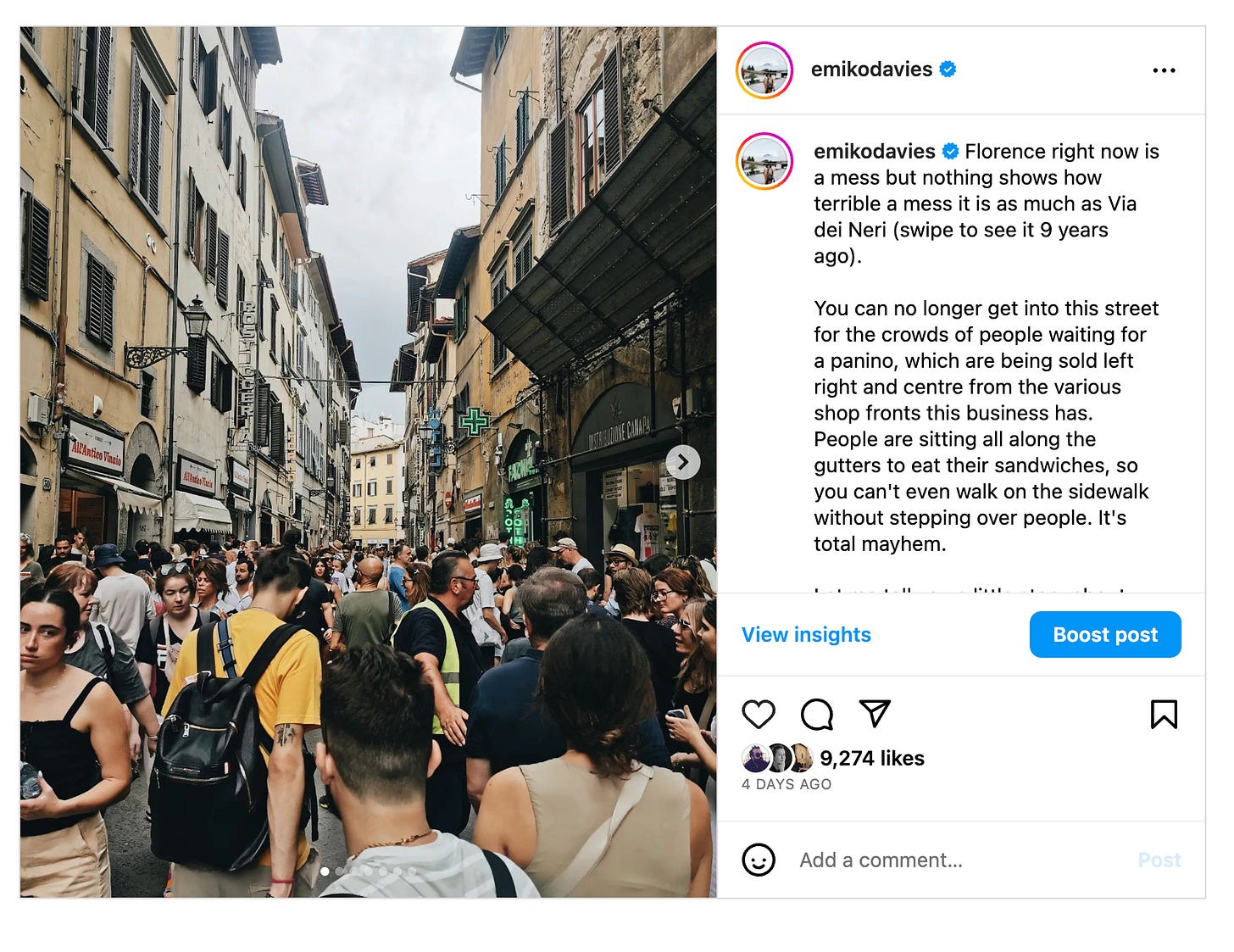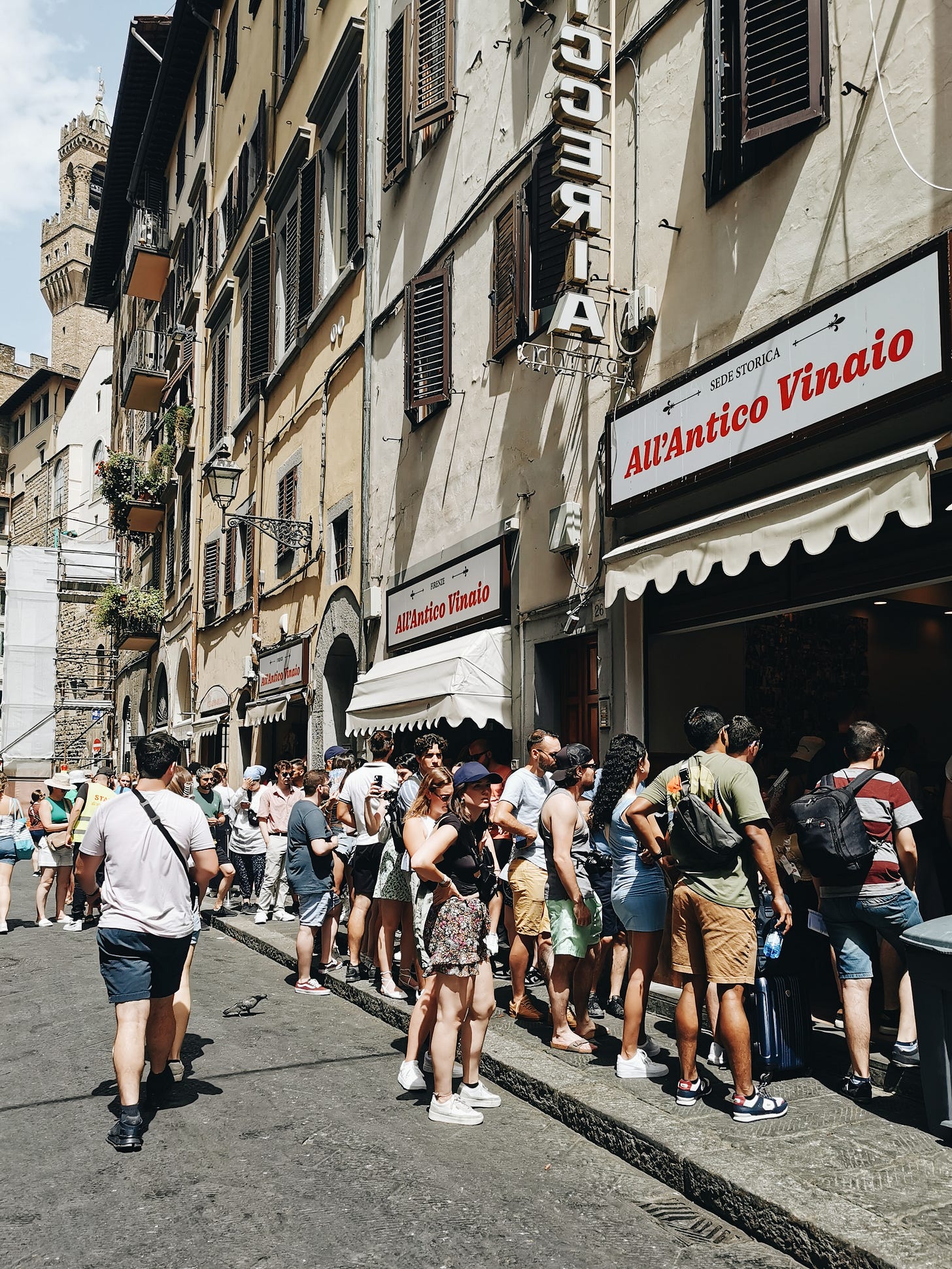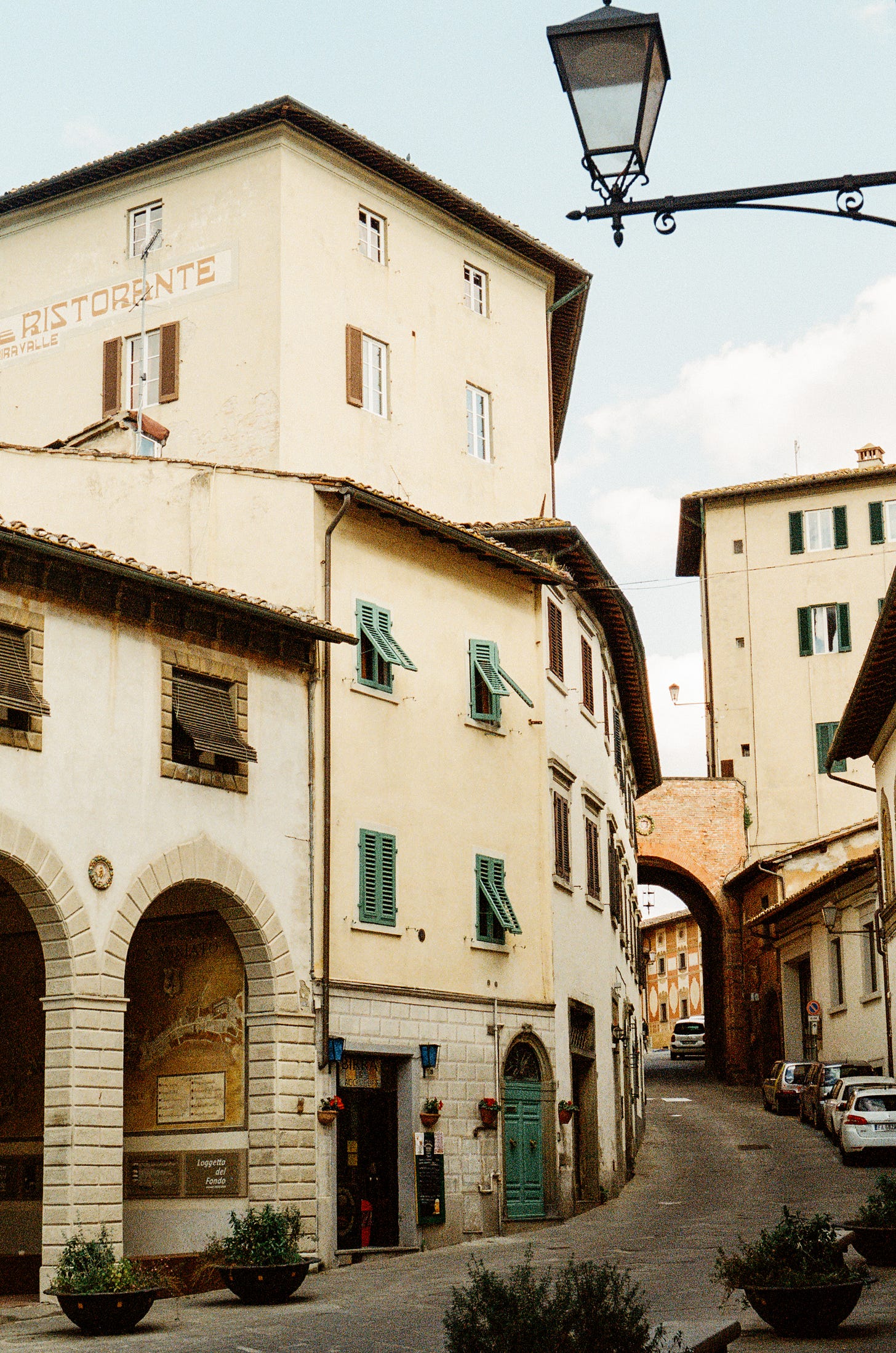I’m away this week to escape the hot humid Tuscan summer for somewhere 10 degrees cooler and to see a friend near Paris. I haven’t been to Paris in over a decade but the visits I’ve made in the past were always to visit friends or my sister, who lived there for a while. I was keen to revisit the neighbourhoods I remembered loving when I could just hang out in cute wine bars and bookshops (all pre-kids obviously!) and I was so sad to hear after an Instagram poll that places like the Marais have changed so much, they’re not only now touristy but those cute little shops had been replaced by standard high street chain stores you see all across Europe.
I’ve been feeling a bit guilty about this upcoming trip to be honest especially since I’ve been talking to people a lot about what I wrote on this instagram post about what a mess Florence is right now with tourists and in particular I just have a bit of a cry about my old neighbourhood. It used to be a charming street, still residential, though a stone’s throw from the Uffizi gallery (I mean what lucky Florentines who got to live right in the heart of their city), with bakeries, butchers, a fruit and veg shop, to prove it. They’ve all disappeared and in their place is a series of sandwich shops — most of them the one same business (a chain that you can now find in NYC, Milan, Rome) that creates unruly crowds of people, rubbish, congestion and people sitting all over the sidewalk and in front of other businesses.
It’s a nightmare. No seating, no bathrooms, no rubbish bins, people standing in line in the frighteningly hot sun for a good 30 minutes, if not longer. More than anything I wanted to tell those poor people there is no need to wait in a long line in the sun, panini are a thing in Florence, you find them on every street corner — in fact, here are my 11 favourite panini in the historical centre and none of these are that panino shop but most of them are minutes walk away from here.
The saddest part about it is the loss of those little local shops, that any residents that may still be there (no doubt most have been kicked by airbnb if they were renters like we were) can no longer get their basics needs from the little local shops that used to be below and now have to get out of the centre of Florence to do their shopping in a supermarket or shopping centre. It’s a big indication that residents are leaving the centre of Florence, which, like Venice, means more and more the centre becomes an amusement park for tourists — and no city (or traveller!) benefits from this.
But I’m so glad that Instagram post has generated so much positive conversation (781 comments! Here’s one I loved below) about the many layers of problems and I wanted to continue the conversation here and perhaps offer some thoughts for solutions to more sustainable travel.
We are killing the very thing we love about the diversity of culture, colour, food etc we love in the world. Everything becomes homogenised, innovation and local identity is lost. The loss is all ours. — Gillian Bell
Most people I know who read my newsletter or follow me on instagram I believe are people who want to travel sustainably and thoughtfully, are curious and want to enjoy themselves too, already that makes a huge difference.
While the layers of the issues behind overcrowding and the “homogenizing” of cities like Florence (and apparently not just in Italy, I got messages from people in Boston, Barcelona, Amsterdam — where they’ve launched a “Stay Away” campaign! — and beyond about similar issues) are many — airbnb driving renters out of their apartments, a city council problem (like Venice’s turnstile proposal to limit the number of people?), a limit on the type of businesses allowed in an area (Lucca has done this for over a decade but in a rather xenophobic way; shops that aren’t delivering something of an Italian tradition are not allowed), etc — here are some thoughts on travelling to Florence (in particular but Italy in general) that will help but also make the trip even better for the traveller.
Don’t stand in line
Ok this is maybe a bit obvious, but I would argue that if you like the idea of eating where the locals eat, then definitely don’t get yourself in a line. Florentines don’t line up. Tourists line up. Florentines just go to the nearest next place (because there is an abundance of choice). That way, too, you’re not adding yourself to a problem and what a line means (this Freakonomics podcast about standing in line was pretty interesting), but you’re also saving yourself time and frustration. You don’t need to get in a long line for a gelato, or a panino, pizza (another problem in another beloved neighbourhood!) or a coffee or really anything else in Florence. Make reservations at restaurants you want to be sure you really get to go to.
Travel in the winter
Or even, in the fall or the spring! Just avoid summer! Actually just even avoid July. See
recent post for more about this:In it she quotes this National Geographic piece, "Sustainable travel is about traveling in a way that's sensitive to the climate and nature emergencies while ensuring that the wellbeing of the places we visit gain long-term benefit from us traveling there. It's a balancing act between maximizing the positives of travel while reducing or eliminating the negatives."
There are so many positives to picking anytime other than July/August to visit Italy, but the number one reason I think is because it’s just TOO HOT. If I could afford to be anywhere else for the entire three months of summer in Tuscany, I would do it every year in a heartbeat. Summer in Tuscany (and Florence is decidedly the worst of any place to be in this season because it is exactly like a pizza oven) is just awful. The heat is debilitating, we have to live like vampires (only going outside at nighttime) and survive by having three cold showers a day, I find it just generally miserable (here’s my piece from 2017 on how to handle an Italian heatwave to give you an idea). It’s only going to get worse.
We try not to do much in the summer, I don’t run workshops in July or August, I only take classes on request. I just want to do less to preserve my health and my energy for the autumn. It’s also just the most crowded time of the year to be in Italy and that’s a combination I find baffling: hot, sweaty, humid and crowded. No thanks.
Reasons to visit the rest of year are thousands; here is a piece on Florence in all four seasons but you might notice I am in love with the autumn more than anything— my absolute favourite time of the year, not the least because it is the furthest time away from the summer! But imagine: not sweating profusely, being able to breathe and wear actual clothes, less crowds, enjoying the seasonal food and wine — personally, Tuscan autumn ingredients are my favourite — newly pressed olive oil, new wine, an abundance of delicious produce from grapes and figs to pumpkins and mushrooms, chestnuts, white truffles! Doesn’t that sound nice?
Base yourself off the beaten track
If you can’t avoid traveling in the summer, this could also help. It might sound a bit cliche but why not base yourself not right in the middle of it all, but somewhere quieter, where locals outnumber the tourists but where you can still get in to see all the things you want to see. It may sound impossible but it’s true, there are still many off the beaten track places to stay in Tuscany, even not far from Florence (see some here), including San Miniato (above), where I live!
Perhaps also consider staying in an agriturismo, a working farm with rooms to stay, rather than a city airbnb apartment for an experience that also supports local farmers and producers — I have a couple of suggestions in the Farm Stay section of my Italian stays post near Florence but there are so many to choose from.
In Venice stay in the lagoon rather than actual Venice. It is the best way to experience Venice, trust me. My next Lagoon Workshop is going to be all about experiencing Venice by not actually spending any time in Venice itself. We will be out on the islands, gliding around the lagoon by boat. It will be magical (also it’s in May; before the heaving crowds).
The idea is to just not add to the crazy, crowded centre and I promise you will enjoy it even more, doubly so if you have kids or are just someone who prefers to avoid crowds. Everyone who has come to visit me in San Miniato and stayed overnight here in one of the (much more affordable than Florence) hotels or apartments has not only not regretted it but told me they’d do it again next time they visit. Here’s my list of places to stay in San Miniato.
Get around with public transport
I don’t want to put any eco guilt onto anyone about plane travel because most people will need a plane to get to Italy and I don’t believe it’s the biggest evil (big oil companies are; they even invented the concept of the “carbon footprint” to make us feel individually responsible for climate change rather than point the blame at them) but once you’re in Italy, you don’t need to fly. As someone who doesn’t drive, public transport for travel, especially the trains, are a great option.
I was having a conversation with my friend Alice Adams in Rome who runs cooking classes at Latteria studio and she was shocked when someone she knew took a flight from Venice to get to Naples. Train travel is so easy in Italy and pretty comfortable. You really don’t need to fly anywhere in Italy (except perhaps to Sicily and even then you can do it by boat if you really wanted to). Fast trains up and down the country are easy, comfortable and quick, especially a route like Venice to Naples (with stops in Bologna, Florence and Rome) but even to get to Turin or to Puglia. We’ve also traveled by ferry to get to islands or by train to the Dolomites by train to Ortisei and around Bolzano and I would say it was easier than going by car (the Alto Adige area is well serviced by buses and cable cars etc too). Bonus, if you’re traveling with wine/liquids (that’s me!) then you don’t have to worry about liquid limits and checking in etc. So much easier.
Regional trains are cheaper and slower but it’s possible to get closer to many other places off the beaten track (in fact, often they are off the beaten track because they are harder to get to or not on a major fast train route — looking at you, Maremma). If you do need a car, consider getting a train to a closer destination and renting a car from there to get around.
Check both Trenitalia and Italo for high-speed train routes and refer to Trenitalia for the regional trains.
Pack light
Not only will I, now in my 40s, refuse to run for a bus or wear uncomfortable shoes but I also refuse to pack a bag that I can’t easily lift. I see people lugging multiple suitcases down the bumpy footpaths in Florence as if they have just literally moved house and are carrying their entire wardrobe with them. I know part of this is down to inexperience (on my mother in law’s first ever international trip, she bought herself a suitcase that is larger than any suitcase I have ever owned or used — and I have moved across hemispheres five times now. I could have fit all my possessions in it! Also she packed a hairdryer, you do not need a hairdryer) and maybe not knowing how uneven Florentine streets are! But how many times have you come back from a trip only to realise you didn’t wear half of the things you brought? I personally like to pack in the smallest suitcase/cabin luggage sized bag on most trips if I can.
A friend pointed out to me that she travels with a large suitcase because she can’t easily find plus-sized clothes while traveling and this is a good point, but then if you are like me, you may not usually buy new clothes while traveling (my trip souvenirs are usually edible ones) anyway. I just try to pack only essentials and re-wear clothes more than once, mixing and matching if needed but not always — if there was ever a reason to try out a capsule wardrobe, it’s a trip where you are likely to be lugging a suitcase up and down stairs!
Another bonus, if you are also doing any train travel (or boat travel or getting onto Venetian vaporetti), it is 1000 x easier to get on and off Italian trains (high steps) with a lighter suitcase.
How is this considered sustainable? Less cargo on planes means less emissions and it’s more fuel efficient in general (even in car travel). Japan Airlines are testing a program where you rent all your clothes in Japan so you don’t have to bring luggage with you (this I would also think is a problem for plus sized people or anyone with my shoe size, EU 40/41, in Japan but think the initiative is interesting).
The bottom line
If you’re reading this post then I’m pretty sure you’re already the kind of person who is a mindful traveller but hopefully there’s something in here that has been helpful, perhaps even to pass on to someone else you know, about when and how to travel in Italy in a more sustainable way. It feels like this is something that might be more and more important to consider, as the world seems to be changing so fast, but also I think all of these cases, you have a win-win situation to make travel also easier and a more memorable experience for you too.
If there’s anything else I might have forgotten or that you’ve experienced traveling recently that you think might be helpful for others to know about, please let me know in the comments!







Great post! My favorite time in Florence is actually January/February. It may be a bit rainy and cold, but we usually have the city to ourselves. Heaven.
Well said!